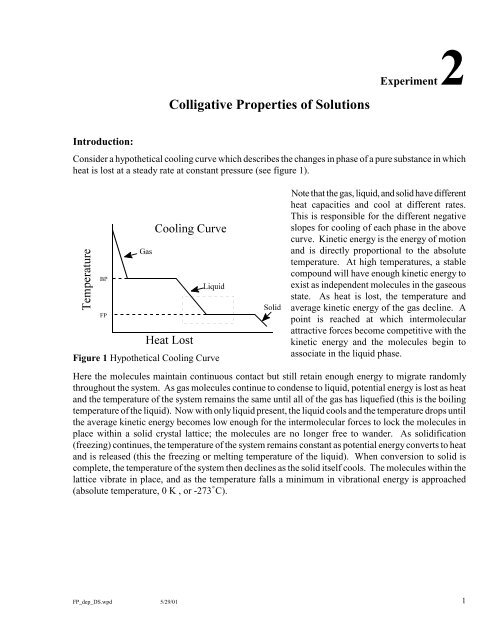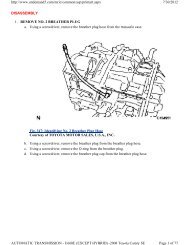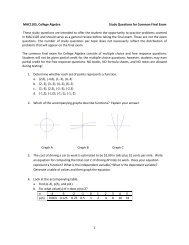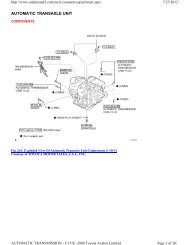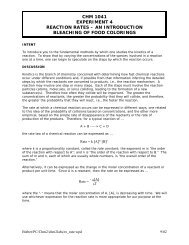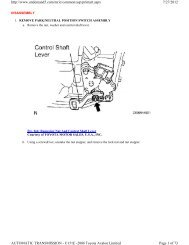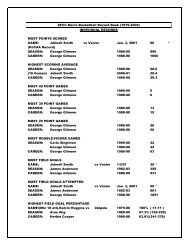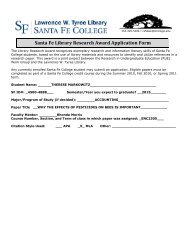Colligative Properties of Solutions
Colligative Properties of Solutions
Colligative Properties of Solutions
You also want an ePaper? Increase the reach of your titles
YUMPU automatically turns print PDFs into web optimized ePapers that Google loves.
Introduction:<br />
Figure 1 Hypothetical Cooling Curve<br />
FP_dep_DS.wpd 5/29/01<br />
<strong>Colligative</strong> <strong>Properties</strong> <strong>of</strong> <strong>Solutions</strong><br />
Experiment 2<br />
Consider a hypothetical cooling curve which describes the changes in phase <strong>of</strong> a pure substance in which<br />
heat is lost at a steady rate at constant pressure (see figure 1).<br />
Note that the gas, liquid, and solid have different<br />
heat capacities and cool at different rates.<br />
This is responsible for the different negative<br />
slopes for cooling <strong>of</strong> each phase in the above<br />
curve. Kinetic energy is the energy <strong>of</strong> motion<br />
and is directly proportional to the absolute<br />
temperature. At high temperatures, a stable<br />
compound will have enough kinetic energy to<br />
exist as independent molecules in the gaseous<br />
state. As heat is lost, the temperature and<br />
average kinetic energy <strong>of</strong> the gas decline. A<br />
point is reached at which intermolecular<br />
attractive forces become competitive with the<br />
kinetic energy and the molecules begin to<br />
associate in the liquid phase.<br />
Here the molecules maintain continuous contact but still retain enough energy to migrate randomly<br />
throughout the system. As gas molecules continue to condense to liquid, potential energy is lost as heat<br />
and the temperature <strong>of</strong> the system remains the same until all <strong>of</strong> the gas has liquefied (this is the boiling<br />
temperature <strong>of</strong> the liquid). Now with only liquid present, the liquid cools and the temperature drops until<br />
the average kinetic energy becomes low enough for the intermolecular forces to lock the molecules in<br />
place within a solid crystal lattice; the molecules are no longer free to wander. As solidification<br />
(freezing) continues, the temperature <strong>of</strong> the system remains constant as potential energy converts to heat<br />
and is released (this the freezing or melting temperature <strong>of</strong> the liquid). When conversion to solid is<br />
complete, the temperature <strong>of</strong> the system then declines as the solid itself cools. The molecules within the<br />
lattice vibrate in place, and as the temperature falls a minimum in vibrational energy is approached<br />
(absolute temperature, 0 K , or -273LC).<br />
1
The Freezing Point <strong>of</strong> Pure Liquid:<br />
This experiment will focus on the region in which the cooling liquid approaches and achieves the<br />
freezing point (The boxed area on cooling curve in figure 1 is seen close up in figure 2).<br />
Figure 2 Cooling Curve <strong>of</strong> Liquid Solvent<br />
The Freezing Point <strong>of</strong> a Solution:<br />
Figure 3 Cooling Curve <strong>of</strong> Typical Solution<br />
2<br />
At the freezing point both liquid and solid are<br />
present. If the system becomes thermally<br />
insulated from its surroundings, that is, heat<br />
can neither enter or leave the system, a state <strong>of</strong><br />
equilibrium will be established. Here the<br />
number <strong>of</strong> molecules moving from solid to<br />
liquid is the same as the number <strong>of</strong> molecules<br />
moving from liquid to solid. This means that<br />
the relative quantities <strong>of</strong> solid and liquid<br />
present will remain constant.<br />
Liquid Solid + Heat<br />
Now consider the effect <strong>of</strong> a nonvolatile solute upon a freezing solution. Any added solute would<br />
dissolve in the liquid phase and be excluded from the solid crystal lattice. This means that, in effect, the<br />
concentration <strong>of</strong> liquid solvent molecules has been diminished and the rate <strong>of</strong> liquid solvent molecules<br />
moving to solid will decrease. On the other hand, the molecules <strong>of</strong> solid solvent (which remains pure),<br />
continue to move from solid to liquid at the same rate. If the temperature is held at the normal freezing<br />
point <strong>of</strong> the pure solvent, the system is thrown out <strong>of</strong> equilibrium and liquid phase is formed at the<br />
expense <strong>of</strong> solid phase, to a point where only liquid solution is present. In order to reestablish freezing,<br />
the temperature <strong>of</strong> the system needs to be lowered. This causes heat to be removed from the system and<br />
restores an equilibrium in which solid is present. The solution, therefore, has a lower freezing<br />
temperature than the pure solvent and the freezing point is said to be depressed.<br />
Now as a solution freezes, solvent molecules<br />
are removed from the liquid solution and<br />
deposited on the solid. This increases the<br />
concentration <strong>of</strong> solute in the liquid solution<br />
and the freezing point further declines. A<br />
solution therefore does not have a sharply<br />
defined freezing point (FP); usually the<br />
freezing point <strong>of</strong> a solution is taken as the<br />
temperature at which solid solvent crystals<br />
first begin to appear (See figure 3).
The FP depression is one <strong>of</strong> a set <strong>of</strong> physical properties <strong>of</strong> solutions (vapor pressure lowering, boiling<br />
point elevation, and osmotic pressure) known collectively as colligative properties. These properties are<br />
affected by the relative quantity <strong>of</strong> solute particles to the relative quantity <strong>of</strong> solvent particles, regardless<br />
<strong>of</strong> the identity <strong>of</strong> the solute particles. The FP depression is described quantitatively by the following<br />
equation: FT = k f m. "F" is the number <strong>of</strong> Celsius degrees the freezing <strong>of</strong> the solution is depressed<br />
relative to the pure solvent. "m" is the molality <strong>of</strong> the solution, that is, the number <strong>of</strong> moles <strong>of</strong> solute<br />
per one kg <strong>of</strong> solvent; this relates the quantity <strong>of</strong> solute to the quantity <strong>of</strong> solvent. "k f" is the molal<br />
freezing point depression constant and expresses the sensitivity <strong>of</strong> the solvent to having the its FP<br />
depressed by an added solute. The units are LC/m, which may be viewed as the number <strong>of</strong> degrees the<br />
FP is depressed per one molal <strong>of</strong> solute concentration. Each solvent has its own unique value for k f.<br />
E.g., Calculate the FP <strong>of</strong> a solution containing 600. g <strong>of</strong> CHCl 3 and 42.0 g <strong>of</strong> eucalyptol, C 10H 18O,<br />
a fragrant substance found in the leaves <strong>of</strong> eucalyptus trees. The FP <strong>of</strong> pure CHCl 3 is -<br />
63.5LC and its k f is 4.68 LC/m.<br />
If a solute is a molecular nonelectrolyte, the solute's molality is a straightforward expression <strong>of</strong> the<br />
concentration <strong>of</strong> molecules in solution, that is, the solution's molality. If, however, the solute is a strong<br />
electrolyte, the effective molality is a whole number multiple (called the van't H<strong>of</strong>f i factor) <strong>of</strong> the solute<br />
molality.<br />
Consider a CaCl 2 solution. CaCl 2 is ionic, and each mole <strong>of</strong> CaCl 2 that dissolves delivers three moles<br />
<strong>of</strong> ions to the solution, which is indicated by the factor "i":<br />
CaCl 2 (s) ssd Ca +2 (aq) + 2 Cl ( aq) i = 3<br />
The effective molality <strong>of</strong> the above solution is "im" or 3m and the FP depression equation becomes:<br />
FT = k f i m or FT = k f 3 m<br />
All <strong>of</strong> the examples in the experimental section to follow will be assumed to remain molecular in<br />
solution and carry an "i" factor <strong>of</strong> one.<br />
3
Experiment 2<br />
Partner<br />
Name<br />
<strong>Colligative</strong> <strong>Properties</strong> <strong>of</strong> <strong>Solutions</strong><br />
EXPERIMENTAL DISCUSSION Experimental Goals:<br />
The experiment to be performed is divided into three sections:<br />
(a) In part A, the FP <strong>of</strong> the pure solvent, cyclohexane, is determined.<br />
(b) Section B determines the value <strong>of</strong> the molal freezing point depression constant, k f , <strong>of</strong> cyclohexane<br />
by measuring the freezing point depression (relative to the FP <strong>of</strong> pure cyclohexane determined in part<br />
A) <strong>of</strong> a solution with a known molality <strong>of</strong> solute.<br />
(c) In part C the molality <strong>of</strong> cyclohexane solution with an unknown solute is found. This makes possible<br />
the calculation <strong>of</strong> the molar mass <strong>of</strong> the unknown.<br />
However, prior to beginning the experiment the temperature probe and CBL must be set up properly.<br />
Setting up the temperature probe and CBL.<br />
1. Plug the temperature probe into the adapter cable. Then plug Probe 1 into Channel 1 <strong>of</strong> the CBL.<br />
Connect the CBL System to the TI-82 calculator with the link cable using the port on the bottom<br />
edge <strong>of</strong> each unit. Firmly press in the cable ends.<br />
2. Fill a 1-liter beaker about 4/5 full with ice. Place the 1-liter beaker on the base <strong>of</strong> the ring stand.<br />
3. Turn on the CBL unit and the TI-82 calculator. Press and select CHEM. Press , then<br />
press again to go to the CHEM MAIN MENU.<br />
4. Set up the calculator and CBL for one temperature probe and one temperature calibration.<br />
Select 1:SET UP PROBES from the CHEM MAIN MENU.<br />
Enter “1” as the number <strong>of</strong> probes.<br />
Select 1:TEMPERATURE from the SELECT PROBE menu.<br />
Enter “1” as the channel number.<br />
Select 3:USE STORED from the CALIBRATION menu.<br />
5. Set up the calculator and CBL for data collection.<br />
Select 2:COLLECT DATA from the CHEM MAIN MENU.<br />
Select 2:TIME GRAPH from the DATA COLLECTION menu.<br />
Enter “15” as the time between samples, in seconds.<br />
Enter “24” as the number <strong>of</strong> samples (the CBL will collect data for a total <strong>of</strong> 6.0 minutes).<br />
Press , then<br />
Select 1:USE TIME SETUP. Do not begin data collection until directed to do so.<br />
5
6<br />
A. FP Determination <strong>of</strong> Pure Solvent, cyclohexane: In this section, a known mass <strong>of</strong> solid<br />
cyclohexane will be cooled and its temperature will be measured as it changes with time. This<br />
data will be plotted yielding a graph similar to figure 2. Ideally the plot would show the steady<br />
cooling <strong>of</strong> the liquid, leading to a constant temperature plateau (the FP or MP) where both the<br />
liquid and solid phases are present (refer again to the boxed area in the cooling curve in figure 1).<br />
The transition from the cooling liquid to the freezing plateau is <strong>of</strong>ten marked by irregularities and<br />
temperatures that are temporarily below the actual freezing temperature. This delay is largely<br />
due to the statistical difficulty in achieving the first microscopic seed crystal from the highly<br />
random liquid molecules. Once this tiny cluster forms, individual molecules may easily add to<br />
the crystal, subsequent crystallization is rapid, and the normal freezing temperature is<br />
established.<br />
Laboratory Procedure for Part A:<br />
1) Measure out about 25 mL <strong>of</strong> dry cyclohexane into one <strong>of</strong> the clean, dry, large test tube.<br />
2) Carefully push the temperature probe through one <strong>of</strong> the holes in the two-hole rubber stopper.<br />
Next, carefully insert the metal stirring rod through the remaining hole in the stopper. Fit the<br />
test tube with the two-hole rubber stopper, metal stirring rod, and temperature probe. Carefully<br />
adjust the probe so that the end is at the midpoint <strong>of</strong> the cyclohexane and centered away from the<br />
walls <strong>of</strong> the test tube.<br />
3) Clamp the test tube assembly to a ring stand in an upright manner.<br />
4) Check the connections between the probe, the CBL system, and the calculator. Make sure the<br />
CBL and calculator are turned on.<br />
5) Carefully lower the test tube and contents into a 400 mL beaker filled with ice.<br />
6) Cover the ice with a thick layer <strong>of</strong> NaCl.<br />
7) Stir the cyclohexane gently. Trigger the CBL and stir continuously until the cyclohexane<br />
becomes slushy or until you can no longer move the stirring rod. When collecting temperature<br />
and time data, the TI-82 calculator will automatically shut <strong>of</strong>f after about 5 minutes. This is not<br />
a problem unless the CBL unit finishes collecting data while the calculator is still <strong>of</strong>f (“DONE”<br />
appears on the CBL screen); if this happens, you will lose your data and have to start over. You<br />
can avoid this by watching the calculator screen and promptly turning it back on when you notice<br />
it is blank. So if the TI-82 screen goes blank, quickly press ON to turn the calculator back on.<br />
8) When the CBL unit finishes collecting data raise the test tube assembly out <strong>of</strong> the ice bath.<br />
9) After the cyclohexane has melted, remove the stopper, stirrer, and temperature probe assembly<br />
from the test tube and set aside to dry. Cover the large test tube containing the cyclohexane and<br />
save for later use.
Data Workup for Part A:<br />
1. Press to display a graph <strong>of</strong> temperature vs. time. Use to examine the data points<br />
along the curve. As you move the cursor right or left, the time (X) and temperature (Y) values<br />
<strong>of</strong> each data point are displayed below the graph. Based on your data, what was the freezing<br />
temperature <strong>of</strong> pure cyclohexane (to the nearest 0.1LC)? Show this to your instructor.<br />
2) Copy the data in L2 from the calculator memory into the data table below.<br />
3) For the lab write-up you will need to prepare a cooling curve by plotting temperature along the<br />
y-axis versus time in seconds along the x-axis using a spread sheet. Turn <strong>of</strong>f the line in the<br />
spreadsheet so the graph shows only the data point themselves. In order to maximize precision,<br />
expand the scale along each axis as much as possible so the data plots allow the reading <strong>of</strong> the<br />
temperature on the graph to ±0.1 LC. Along both the cooling-liquid portion <strong>of</strong> the data and along<br />
the freezing portion, draw for each the best straight line possible (use a straight edge) that gives<br />
a weighted average <strong>of</strong> all the data points (see figure 2). Note that no one data point is required<br />
to fall on this line; in fact, it is possible that none <strong>of</strong> these points may fall on this line. The<br />
intersection <strong>of</strong> these two lines in the region <strong>of</strong> supercooling yields the best estimate <strong>of</strong> the<br />
freezing temperature <strong>of</strong> the liquid. Record this temperature on the data sheet below (with<br />
greatest possible precision) as the observed freezing point <strong>of</strong> pure cyclohexane.<br />
Data Table for Part A:<br />
15 s________ 105 s________ 195 s________ 285 s________<br />
30 s________ 120 s________ 210 s________ 300 s________<br />
45 s________ 135 s________ 225 s________ 315 s________<br />
60 s________ 150 s________ 240 s________ 330 s________<br />
75 s________ 165 s________ 255 s________ 345 s________<br />
90 s________ 180 s________ 270 s________ 360 s________<br />
Observed FP <strong>of</strong> pure cyclohexane:_________<br />
7
8<br />
B. Determination <strong>of</strong> k f <strong>of</strong> cyclohexane: In this procedure, the molal freezing point depression<br />
constant, k f , <strong>of</strong> cyclohexane will be determined experimentally. The freezing temperature will<br />
be found for a solution using a known mass <strong>of</strong> cyclohexane as the solvent and a measured mass<br />
<strong>of</strong> naphthalene as the solute. The freezing point depression, FT , <strong>of</strong> the solution is found by<br />
calculating the difference between the freezing temperature <strong>of</strong> the solution and the freezing<br />
temperature <strong>of</strong> the pure solvent found in part A. After the molality <strong>of</strong> the solution, m , is<br />
computed from the known masses <strong>of</strong> solute and solvent, the k f may be calculated: k f = FT/ m<br />
Laboratory Procedure for Part B:<br />
1) Place the second large, dry test tube into a 250 mL erlenmeyer flask with the tube up-right.<br />
Weigh and record on the data sheet below the combined mass <strong>of</strong> this setup to the nearest 0.001 g<br />
on the electronic reagent balance in the laboratory. Carefully, add about 1.0 g <strong>of</strong> naphthalene to<br />
the test tube, and record the mass <strong>of</strong> the naphthalene and glassware to the nearest 0.001 g.<br />
2) Carefully pour the cyclohexane from the first test tube into the second tube. Weigh and record<br />
the mass <strong>of</strong> the flask, test tube and contents to the nearest 0.001 g. Set the empty first test tube<br />
aside to dry for later use in Part C.<br />
3) Fit the second test tube with the stopper, stirring rod, and temperature probe. Carefully adjust<br />
the probe so that the end is at the midpoint <strong>of</strong> the cyclohexane and centered away from the walls<br />
<strong>of</strong> the test tube.<br />
4) Attach the probe to the CBL system as before.<br />
5) Re-set the CBL to take data every 15 seconds in “time graph” mode.<br />
6) Carefully lower the test tube and contents into the beaker filled with the ice and NaCl mixture.<br />
7) Stir the cyclohexane gently. Trigger the CBL and stir continuously until the cyclohexane<br />
becomes slushy or until you can no longer move the stirring rod.<br />
8) When the CBL unit finishes collecting data raise the test tube assembly out <strong>of</strong> the ice bath.<br />
9) After the cyclohexane has melted, remove the stopper, stirrer, and temperature probe assembly.<br />
Discard the cyclohexane/naphthalene mixture into the proper waste container. Rinse the stopper<br />
assembly with fresh cyclohexane being sure to collect the rinse and to discard it into the waste<br />
container. Set the assembly aside to dry for use in Part C.
Data Workup for Part B:<br />
1. Press to display a graph <strong>of</strong> temperature vs. time. Use to examine the data points<br />
along the curve. As you move the cursor right or left, the time (X) and temperature (Y) values<br />
<strong>of</strong> each data point are displayed below the graph. Based on your data, what was the freezing<br />
temperature <strong>of</strong> cyclohexane/naphthalene mixture (to the nearest 0.1LC)?<br />
Show this to your instructor.<br />
2) Copy the data in L2 from the calculator memory into the data table below.<br />
3) As in Part A, prepare a cooling curve by plotting temperature along the y-axis versus time in<br />
seconds along the x-axis using a spread sheet. Turn <strong>of</strong>f the line in the spreadsheet so the graph<br />
shows only the data point themselves. Use a straight edge to draw a line through the data along<br />
both the cooling-liquid portion <strong>of</strong> the data and along the freezing portion. Remember that as the<br />
solution freezes, the liquid becomes ever more concentrated in solute, and the freezing<br />
temperature steadily decreases. The intersection <strong>of</strong> these two lines in the region <strong>of</strong> supercooling<br />
yields the best estimate <strong>of</strong> the freezing temperature <strong>of</strong> the mixture. Record this temperature on<br />
the data sheet (with greatest possible precision) as the observed freezing point <strong>of</strong> the solution.<br />
Data Table for Part B:<br />
Mass <strong>of</strong> test-tube and flask:____________<br />
Mass <strong>of</strong> test-tube, flask, and naphthalene:____________<br />
Calculated mass <strong>of</strong> naphthalene:____________<br />
Mass <strong>of</strong> test-tube, flask, naphthalene and cyclohexane:____________<br />
Temperature/time data:<br />
Calculated mass <strong>of</strong> cyclohexane:____________<br />
15 s________ 105 s________ 195 s________ 285 s________<br />
30 s________ 120 s________ 210 s________ 300 s________<br />
45 s________ 135 s________ 225 s________ 315 s________<br />
60 s________ 150 s________ 240 s________ 330 s________<br />
75 s________ 165 s________ 255 s________ 345 s________<br />
90 s________ 180 s________ 270 s________ 360 s________<br />
Observed FP <strong>of</strong> cyclohexane/naphthalene solution: ___________<br />
9
10<br />
C. Determination <strong>of</strong> the Molar Mass <strong>of</strong> the Unknown: In this section, a measured mass <strong>of</strong> an<br />
unknown solute will be added to a fresh sample <strong>of</strong> cyclohexane solvent, whose mass is also<br />
known. The freezing point depression, FT, <strong>of</strong> this solution will be determined. Since k f has<br />
been found in part B, the molality <strong>of</strong> the solution containing the unknown, m, may be calculated:<br />
m = FT/k f. The molality, which is in units <strong>of</strong> moles solute per kg <strong>of</strong> solvent, may now be used<br />
to find the number <strong>of</strong> moles <strong>of</strong> unknown solute present, and, since the mass <strong>of</strong> the unknown was<br />
determined in the beginning, the molar mass may now be calculated. Watch your units. They<br />
insure a proper sequence <strong>of</strong> calculations.<br />
Laboratory Procedure for Part C:<br />
1) Obtain your unknown. Record this number on the data sheet.<br />
2) Place the remaining dry, large test tube into a 250 mL erlenmeyer flask with the tube up-right.<br />
Weigh and record the combined mass <strong>of</strong> this setup to the nearest 0.001 g.<br />
3) Carefully pour your entire unknown into the test tube and re-weigh the entire apparatus to the<br />
nearest 0.001g.<br />
4) Measure out about 25 mL <strong>of</strong> fresh cyclohexane with a graduated cylinder and pour it carefully<br />
into the test tube with your unknown being sure to rinse down the inside wall <strong>of</strong> the tube with<br />
the cyclohexane.<br />
5) Fit the test tube with the stopper, stirring rod, and temperature probe. Carefully adjust the probe<br />
so that the end is at the midpoint <strong>of</strong> the cyclohexane and centered away from the walls <strong>of</strong> the test<br />
tube.<br />
6) Attach the probe to the CBL system as before. Re-set the CBL to take data every 15 seconds in<br />
“time graph” mode.<br />
7) Carefully lower the test tube and contents into the beaker filled with ice/salt mixture.<br />
8) Stir the cyclohexane gently. Trigger the CBL and stir continuously until the cyclohexane<br />
becomes slushy or until you can no longer move the stirring rod.<br />
9) When the CBL unit finishes collecting data raise the test tube assembly out <strong>of</strong> the ice bath.<br />
10) After the cyclohexane has melted, remove the stopper, stirrer, and temperature probe assembly.<br />
Discard the cyclohexane/unknown mixture into the proper waste container. Rinse the stopper<br />
assembly with fresh cyclohexane being sure to collect the rinse and to discard it into the waste<br />
container. Return the equipment.
Data Workup for Part C:<br />
1. Press to display a graph <strong>of</strong> temperature vs. time. Use to examine the data points<br />
along the curve. As you move the cursor right or left, the time (X) and temperature (Y) values <strong>of</strong><br />
each data point are displayed below the graph. Based on your data, what was the freezing<br />
temperature <strong>of</strong> cyclohexane/unknown mixture (to the nearest 0.1LC)?<br />
Show this to your instructor.<br />
2) Copy the data in L2 from the calculator memory onto your lab.<br />
3) As in Part A, prepare a cooling curve by plotting temperature along the y-axis versus time in<br />
seconds along the x-axis using a spread sheet. Turn <strong>of</strong>f the line in the spreadsheet so the graph<br />
shows only the data point themselves. Use a straight edge to draw a line through the data along<br />
both the cooling-liquid portion <strong>of</strong> the data and along the freezing portion. Remember that as the<br />
solution freezes, the liquid becomes ever more concentrated in solute, and the freezing<br />
temperature steadily decreases. The intersection <strong>of</strong> these two lines in the region <strong>of</strong> supercooling<br />
yields the best estimate <strong>of</strong> the freezing temperature <strong>of</strong> the mixture. Record this temperature on<br />
the data sheet (with greatest possible precision) as the observed freezing point <strong>of</strong> the<br />
cyclohexane/unknown solution.<br />
Data Table for Part C:<br />
Mass <strong>of</strong> test-tube and flask:____________<br />
Mass <strong>of</strong> test-tube, flask, and unknown:____________<br />
Calculated mass <strong>of</strong> unknown:____________<br />
Mass <strong>of</strong> test-tube, flask, unknown and cyclohexane:____________<br />
Temperature/time data:<br />
Calculated mass <strong>of</strong> cyclohexane:____________<br />
15 s________ 105 s________ 195 s________ 285 s________<br />
30 s________ 120 s________ 210 s________ 300 s________<br />
45 s________ 135 s________ 225 s________ 315 s________<br />
60 s________ 150 s________ 240 s________ 330 s________<br />
75 s________ 165 s________ 255 s________ 345 s________<br />
90 s________ 180 s________ 270 s________ 360 s________<br />
Observed FP <strong>of</strong> cyclohexane/unknown solution: ___________<br />
11
12<br />
CALCULATIONS/QUESTIONS<br />
1. a) From the freezing points <strong>of</strong> pure cyclohexane and the cyclohexane/naphthalene solution,<br />
calculate the freezing point depression, FT , <strong>of</strong> the cyclohexane/naphthalene solution.<br />
b) For the cyclohexane/naphthalene solution in part B, calculate the number <strong>of</strong> moles <strong>of</strong><br />
naphthalene added (naphthalene, C 10H 8). Then calculate the molality <strong>of</strong> the solution.<br />
c) From the molality <strong>of</strong> the cyclohexane/naphthalene solution just calculated, and the freezing<br />
point depression, FT , <strong>of</strong> the cyclohexane/naphthalene solution, calculate the value <strong>of</strong> the molal<br />
freezing point depression constant, k f , for cyclohexane.<br />
2. a) From the freezing points <strong>of</strong> pure cyclohexane and the cyclohexane/unknown solution, calculate<br />
the freezing point depression, FT , <strong>of</strong> the cyclohexane/unknown solution.<br />
b) From the k f <strong>of</strong> cyclohexane calculated above and the freezing point depression, FT , <strong>of</strong> the<br />
cyclohexane/unknown solution in 2a, calculate the molality, m , <strong>of</strong> the cyclohexane/unknown<br />
solution.<br />
c) For part C, having measured the mass <strong>of</strong> the unknown acid solute and the mass <strong>of</strong> the<br />
cyclohexane solvent, and having just found the molality <strong>of</strong> the cyclohexane/unknown solution,<br />
calculate the apparent molar mass <strong>of</strong> the unknown.


